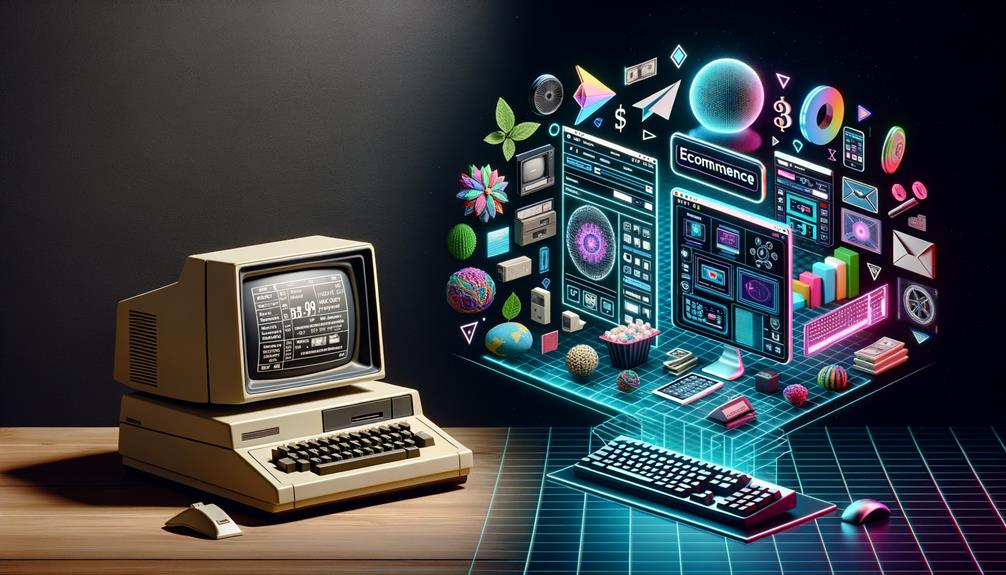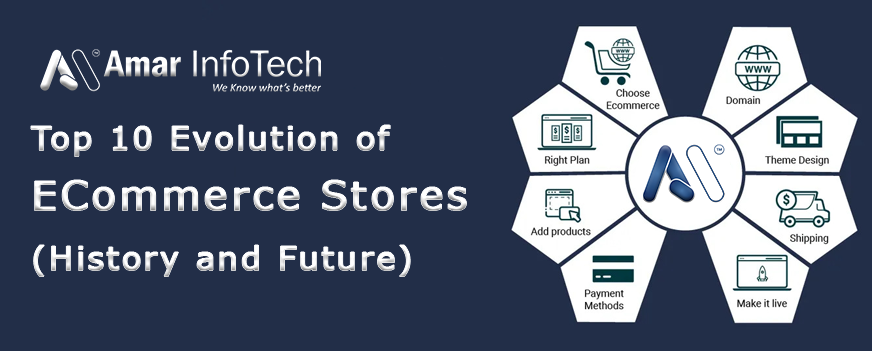E-commerce started in the 1970s with electronic data interchange (EDI). It evolved dramatically with the internet boom in the 1990s.
E-commerce has transformed how we shop and do business. Online shopping platforms offer convenience and variety. The rise of smartphones has made e-commerce accessible to everyone. Companies now focus on enhancing user experience and personalization. The future of e-commerce involves augmented reality, AI-driven recommendations, and seamless payment solutions.
Sustainability and eco-friendly practices are also gaining importance. Small businesses can compete globally through e-commerce. The industry continues to grow rapidly, adapting to new technologies and consumer preferences. This dynamic field promises to revolutionize retail further.
Early Beginnings
The history of e-commerce is rich and fascinating. It started with simple transactions and has grown into a global marketplace. This section dives into the early days of online shopping.
First Online Transactions
The first online transaction happened in 1971. Students from Stanford and MIT used ARPANET to sell cannabis. This marked the start of online shopping. By 1994, the first secure online purchase was made. A man bought a CD by Sting using his credit card.
Pioneering Companies
Some companies led the way in e-commerce. Amazon started in 1994. Jeff Bezos launched it as an online bookstore. It quickly grew into a massive online marketplace. eBay followed in 1995. Pierre Omidyar created it as an auction website. Users could buy and sell items online.
| Year | Event |
|---|---|
| 1971 | First online transaction on ARPANET |
| 1994 | First secure online purchase |
| 1994 | Amazon was founded |
| 1995 | eBay was founded |
Both Amazon and eBay changed how people shop. They made it easy to buy items from home. These companies set the stage for modern e-commerce. Their success inspired many others to start online businesses.
- Amazon: Started as a bookstore, now a global marketplace.
- eBay: Began as an auction site, now a major e-commerce platform.
These pioneering companies showed the world the potential of online shopping. They created a new way to buy and sell goods. Their impact is still felt today.

Credit: www.geteasycart.com
Dot-com Boom
The Dot-Com Boom was a period of rapid Internet growth. It started in the late 1990s and peaked in the early 2000s. During this time, many Internet-based companies emerged. The boom was fueled by speculative investments and the promise of online commerce. This period saw the birth of many online retailers and innovations in e-commerce.
Rise Of Online Retailers
The Dot-Com Boom saw the rise of many online retailers. Companies like Amazon and eBay began to dominate the market. These platforms offered a new way to shop. Consumers could now buy products from home. This convenience attracted many users. Online shopping became a popular trend.
Small businesses also joined the online market. They created websites to reach more customers. The Internet provided a global audience. This helped many businesses grow rapidly. The rise of online retailers changed the way people shopped forever.
Market Speculation
The Dot-Com Boom was marked by high market speculation. Investors poured money into Internet startups. They believed these companies would bring huge returns. Many startups had high valuations but low profits. This created a financial bubble.
Eventually, the market could not sustain the hype. Many companies failed to deliver on their promises. The bubble burst in 2000. This led to significant financial losses. Despite this, some companies survived and thrived. They adapted and evolved, shaping the future of e-commerce.
| Company | Founded | Key Contribution |
|---|---|---|
| Amazon | 1994 | Revolutionized online retail |
| eBay | 1995 | Popularized online auctions |
| Pets.com | 1998 | Failed due to over-speculation |
Despite the burst, the Dot-Com Boom set the stage for future e-commerce growth. Lessons learned during this time continue to influence the industry. The rise of online retailers and market speculation were key elements. They shaped the landscape of modern online shopping.
Dot-com Bust
The Dot-Com Bust refers to the period between 1999 and 2001. Many online companies failed during this time. The boom turned into a bust, leading to a market crash. Investors lost billions. Yet, some companies survived and thrived.
Market Crash
The market crash happened in early 2000. Overvalued stocks crashed. Many companies shut down. Investors panicked and sold their shares. The NASDAQ fell by 78%. It was a financial disaster.
Here are some key reasons for the crash:
- Overvaluation of tech stocks
- Lack of solid business models
- Massive speculative investments
| Year | NASDAQ Index |
|---|---|
| 1999 | 5,000 |
| 2000 | 3,000 |
| 2001 | 1,500 |
Surviving Companies
Many companies did not survive the bust. Yet, a few did. These companies had strong business models.
Some of the surviving companies include:
- Amazon
- eBay
These companies adapted and grew stronger. They focused on customer needs. They innovated and expanded. Today, they are industry giants.

Credit: startupanz.com
Evolution In The 2000s
The 2000s were a transformative decade for e-commerce. This period saw rapid growth and significant changes in the way online businesses operated. Key developments included the advent of payment gateways and the growth of online marketplaces.
Advent Of Payment Gateways
The early 2000s introduced payment gateways like PayPal. These gateways made online transactions secure and easy. Before this, online shopping was risky. Payment gateways changed the game by providing encrypted transactions.
Payment gateways offered:
- Secure transactions
- Faster payment processing
- Better user experience
These benefits led to a rise in online shoppers and increased trust in e-commerce.
Growth Of Online Marketplaces
The 2000s also saw the rise of online marketplaces. Websites like Amazon and eBay became household names. These platforms allowed sellers to reach global audiences.
Key features of online marketplaces:
| Feature | Benefit |
|---|---|
| Diverse product range | One-stop shopping experience |
| Customer reviews | Informed purchasing decisions |
| Competitive pricing | Better deals for consumers |
These platforms provided a convenient shopping experience, leading to their explosive growth.
Mobile Commerce
Mobile commerce, or m-commerce, has transformed the online shopping landscape. With smartphones, shopping is now at our fingertips, anytime, anywhere.
Smartphones Revolution
Smartphones have changed how we shop online. These devices are more than just phones; they are mini-computers. With them, we can browse stores, compare prices, and read reviews. This has made shopping easier and faster.
In the past, people used computers for e-commerce. Now, smartphones are the primary tool. They offer convenience and flexibility. As a result, mobile commerce has grown rapidly.
Statistics show that more than half of online shoppers use smartphones. This trend is likely to continue. Businesses must adapt to this change.
Mobile Payment Solutions
Mobile payment solutions have made m-commerce even more attractive. They allow for quick and secure transactions. Popular options include Apple Pay, Google Wallet, and Samsung Pay.
These solutions use advanced technology. They ensure that personal information is safe. This has increased trust in mobile commerce.
Many stores now accept mobile payments. This has made shopping easier for customers. They can pay with a tap of their phone.
| Feature | Benefit |
|---|---|
| Convenience | Shop anytime, anywhere |
| Speed | Quick transactions |
| Security | Safe payments |
- Mobile commerce is growing fast.
- Smartphones are key to this growth.
- Mobile payments are secure and convenient.
E-commerce Today
Today’s e-commerce landscape is vibrant and fast-paced. It has grown remarkably from its humble beginnings. Online shopping is now an integral part of our daily lives. Let’s explore the current state of e-commerce.
Dominant Players
Several companies dominate the e-commerce market today. Here are the key players:
- Amazon: The largest online retailer globally. It offers a vast range of products.
- Alibaba: A major player in China. It serves millions of customers worldwide.
- eBay: Known for auctions and consumer-to-consumer sales.
- Walmart: A retail giant that has expanded significantly online.
These companies have changed how we shop. They offer convenience and variety at our fingertips.
Diverse Product Categories
Online stores offer a wide range of product categories. Let’s look at some of the most popular ones:
| Category | Description |
|---|---|
| Electronics | Smartphones, laptops, and other gadgets are top sellers. |
| Fashion | Clothing, shoes, and accessories from various brands. |
| Home & Kitchen | Furniture, appliances, and decor for every room. |
| Books | Printed and digital books for every reader. |
| Health & Beauty | Skincare, haircare, and wellness products. |
E-commerce platforms cater to diverse needs. From daily essentials to luxury items, you can find almost anything online. This variety attracts a broad range of customers. It also encourages repeat purchases.
Technological Advancements
The evolution of e-commerce is deeply tied to technological advancements. These advancements shape how we buy and sell online. Two significant areas are AI and machine learning, and augmented reality.
Ai And Machine Learning
Artificial Intelligence (AI) and Machine Learning (ML) play crucial roles in e-commerce. They help in personalizing the shopping experience. AI-driven chatbots provide instant customer support. This boosts customer satisfaction.
ML algorithms analyze vast amounts of data. They predict customer behavior. This helps in targeted marketing. E-commerce platforms use AI to recommend products. These recommendations are based on past purchases. This increases sales.
| AI Applications | Benefits |
|---|---|
| Chatbots | Instant customer support |
| Product Recommendations | Personalized shopping experience |
| Data Analysis | Predict customer behavior |
Augmented Reality
Augmented Reality (AR) changes how we shop online. AR allows customers to see products in a real-world setting. This enhances the shopping experience. For example, customers can see how furniture looks in their home.
Many e-commerce platforms use AR to showcase products. This reduces the return rates. Customers make more informed decisions. AR also helps in trying out clothes virtually. This is useful for fashion e-commerce. AR bridges the gap between online and offline shopping.
- See products in real-world settings
- Reduced return rates
- Informed purchasing decisions
- Virtual try-on for clothes
Technological advancements are driving the future of e-commerce. AI and ML personalize shopping. AR enhances product visualization. Together, they create a seamless and enjoyable shopping experience.

Credit: ibvi.org
Future Trends
The world of e-commerce evolves rapidly. As we look ahead, several key trends will shape its future. These trends focus on sustainability, security, and advanced technology. They promise to revolutionize how we shop and sell online.
Sustainability In E-commerce
Sustainability is a growing priority in e-commerce. Online retailers now focus on eco-friendly practices. They aim to reduce their carbon footprint and promote green products.
- Using recyclable packaging
- Offering carbon-neutral shipping
- Promoting second-hand and refurbished items
Customers prefer brands that care for the environment. They look for companies that practice responsible sourcing. Businesses adopting sustainable practices gain a competitive edge.
Blockchain And Security
The future of e-commerce includes blockchain technology. Blockchain offers enhanced security and transparency. It ensures safe transactions and protects customer data.
| Benefits of Blockchain | How It Helps E-Commerce |
|---|---|
| Improved Security | Secures customer transactions |
| Transparency | Tracks product origins and supply chains |
| Fraud Prevention | Reduces counterfeit goods |
Using blockchain, businesses can build trust with customers. It creates a secure and transparent shopping experience. This technology is essential for the future of online shopping.
Conclusion
E-commerce has transformed how we shop and conduct business. Its history shows rapid growth and innovation. The future holds even more advancements. Embracing these changes can lead to new opportunities. Stay informed and adaptable to thrive in this evolving landscape.
E-commerce is here to stay, reshaping our world.

